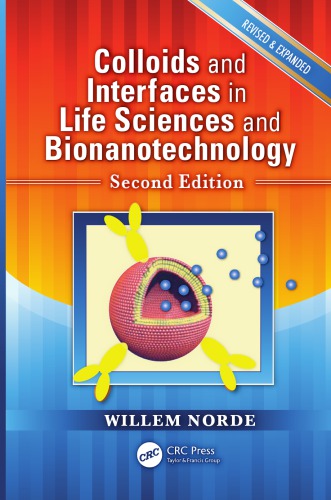

Most ebook files are in PDF format, so you can easily read them using various software such as Foxit Reader or directly on the Google Chrome browser.
Some ebook files are released by publishers in other formats such as .awz, .mobi, .epub, .fb2, etc. You may need to install specific software to read these formats on mobile/PC, such as Calibre.
Please read the tutorial at this link. https://ebooknice.com/page/post?id=faq
We offer FREE conversion to the popular formats you request; however, this may take some time. Therefore, right after payment, please email us, and we will try to provide the service as quickly as possible.
For some exceptional file formats or broken links (if any), please refrain from opening any disputes. Instead, email us first, and we will try to assist within a maximum of 6 hours.
EbookNice Team

Status:
Available4.4
37 reviews
ISBN-10 : 1439873038
ISBN-13 : 9781439873038
Author: Willem Norde
Colloidal systems occur everywhere—in soils, seawater, foodstuff, pharmaceuticals, paints, blood, biological cells, and microorganisms. Colloids and Interfaces in Life Sciences and Bionanotechnology, Second Edition, gives a concise treatment of physicochemical principles determining interrelated colloidal and interfacial phenomena.
Introduction
Colloidal Domain
Interfaces Are Closely Related to Colloids
Colloid and Interface Science in a Historical Perspective
Classification of Colloidal Systems
Colloidal Particles: Shapes and Size Distributions
Shapes
Particle Size Distributions
Average Molar Mass.
Specific Surface Area
Some Thermodynamic Principles and Relations, with Special Attention to Interfaces
Energy, Work, and Heat: The First Law of Thermodynamics
The Second Law of Thermodynamics: Entropy
Reversible Processes: Definition of Intensive Variables
Introduction of Other Functions of State: Maxwell Relations
Molar Properties and Partial Molar Properties: Dependence of the Chemical Potential on Temperature, Pressure, and Composition of the System
Criteria for Equilibrium: Osmotic Pressure
Phase Equilibria, Partitioning, Solubilization, and Chemical Equilibrium
Entropy of Mixing
Excess Nature of Interfacial Thermodynamic Quantities: The Gibbs Dividing Plane
Gibbs–Duhem Relation
Gibbs Adsorption Equation
Some Applications of the Gibbs Adsorption Equation
Nonideal Mixtures
Water
Phenomenological Aspects of Water
Molecular Properties of Water
Water as a Solvent
Interfacial Tension
Interfacial Tension: Phenomenological Aspects.
Interfacial Tension as a Force: Mechanical Definition of Interfacial Tension
Interfacial Tension as an Interfacial (Gibbs) Energy: Thermodynamic Definition of Interfacial Tension
Operational Restrictions of Interfacial Tension
Interfacial Tension and the Works of Cohesion and Adhesion
Molecular Interpretation of Interfacial Tension
Curvature and Capillarity
Capillary Pressure: The Young–Laplace Equation
.Radii of Curvature
Some Consequences of Capillary Pressure
Curvature and Chemical Potential: Kelvin’s Law and Ostwald’s Law Curvature and Nucleation
Monolayers at Fluid Interfaces
The Interfacial Pressure.
Gibbs and Langmuir Monolayers: Equations of State.
Formation of Monolayers
Pressure–Area Isotherms of Langmuir Monolayers: Two-Dimensional Phases
Transfer of Monolayers to Solid Surfaces: Langmuir–Blodgett and Langmuir–Schaefer Films
Covalent Organic Monolayers
Wetting of Solid Surfaces
Contact Angle: Equation of Young and Dupré
Some Complications in the Establishment of the
Contact Angle: Hysteresis, Surface Heterogeneity, and Roughness
Wetting and Adhesion: Determination of Surface Polarity
Approximation of the Surface Tension of a Solid: The Critical Surface Tension of Wetting
Wetting by Solutions Containing Surfactants
Capillary Penetration
Some Practical Applications and Implications of Wetting: Impregnation, Flotation, Pickering Stabilization, and Cleansing
Electrochemistry of Interfaces
Electric Charge
Electric Potential
The Gibbs Energy of an Electrical Double Layer
Models for the Electrical Double Layer
Donnan Effect, Donnan Equilibrium, Colloidal Osmotic Pressure, and Membrane Potential Exercises
Electrokinetic Phenomena
The Plane of Shear: The Zeta Potential
Derivation of the Zeta Potential from Electrokinetic
Phenomena
Some Complications in Deriving the Zeta Potential
Interpretation of the Zeta Potential
Applications of Electrokinetic Phenomena
Self-Assembly of Amphiphilic Molecules
Self-Assembly as Phase Separation
Different Types of Self-Assembled Structures
Aggregation as a "Start–Stop" Process: Size and Shape of Self-Assembled Structures
Mass Action Model for Micellization
Factors That Influence the Critical Micelle Concentration
Bilayer Structures
Reverse Micelles
Microemulsions
Self-Assembled Structures in Applications
Polymers
Polymers in Solution
Conformations of Dissolved Polymer Molecules.
Coil-Like Polymer Conformations
Semi-Dilute and Concentrated Polymer Solutions
Polyelectrolytes
Phase Separations in Polymer Solutions: Complex Coacervation
Polymer–Surfactant.
Polymer Gels
Proteins
The Amino Acids in Proteins
The Three-Dimensional Structure of Protein Molecules in Aqueous Solution
Noncovalent Interactions That Determine the Structure of a Protein Molecule in Water
Stability of Protein Structure in Aqueous Solution.
Thermodynamic Analysis of Protein Structure Stability
Reversibility of Protein Denaturation: Aggregation of Unfolded Protein Molecules
Adsorption
Adsorbent–Adsorbate Interactions
Adsorption Kinetics.
Adsorption Equilibrium
Binding of Ligands
Applications of Adsorption
Adsorption of (Bio)Polymers, with Special Emphasis on Globular Proteins
Adsorption Kinetics.
Morphology of the Interface
Relaxation of the Adsorbed Molecule
Adsorption Affinity: Adsorption Isotherm
Driving Forces for Adsorption of Globular Proteins
Reversibility of the Protein Adsorption Process: Desorption and Exchange
Competitive Protein Adsorption Exercises
Stability of Lyophobic Colloids against Aggregation
Forces Operating between Colloidal Particles
DLVO Theory of Colloid Stability
Influence of Polymers on Colloidal Stability.
Aggregation Kinetics
Morphology of Colloidal Aggregates
Rheology, with Special Attention to Dispersions and Interfaces
Rheological Properties
Classification of Materials Based on Their Rheological Behavior
Viscosity of Diluted Liquid Dispersions
Interfacial Rheology
Emulsions and Foams
Phenomenological Aspects
Emulsification and Foaming
Emulsion and Foam Stability.
Modulation of the Coarseness and Stability of Emulsions and Foams
Physicochemical Properties of Biological Membranes
Structure and Dynamics of Biomembranes
Electrochemical Properties of Biomembranes
Transport in Biological Membranes
Transmembrane Potential
Exercises
Suggestions for Further Reading
Bioadhesion
A Qualitative Description of Biofilm Formation
Biological Surfaces
Physicochemical Models for Cell Deposition and Adhesion
Surface Modification to Reduce (Bio)Adhesion
General Thermodynamic Analysis of Particle Adhesion
colloids and interfaces abbreviation
colloids and interfaces mdpi impact factor
interfaces and colloids
interface and colloid science
j. colloid. interface. sci
Tags: Colloids, Interfaces, Life Sciences, Bionanotechnology, Willem Norde